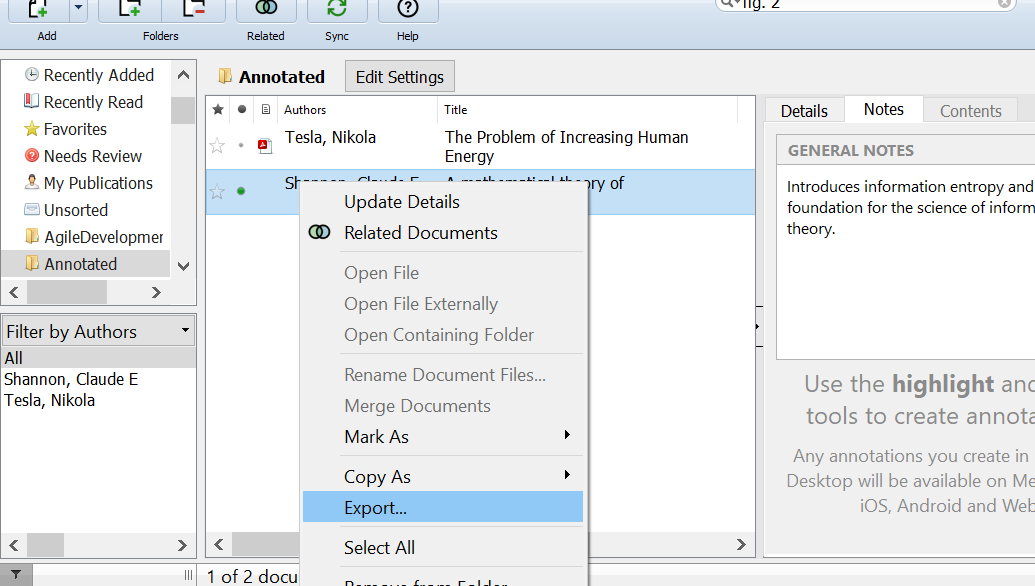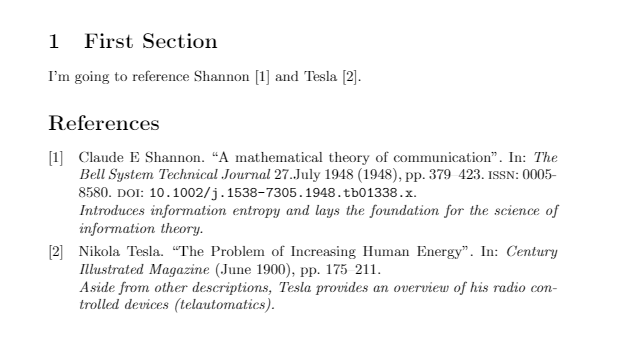Mendeley Annotated Bibliography LaTeX Template
This quick tutorial shows a way to produce an annotated bibliography for any written documents that are produced using LaTeX. In this tutorial the online Overleaf service was used for document production. However, other LaTeX document production techniques can be used, for example the offline MiKTeX program.

What is an Annotated Bibliography
A bibliography or list of references shows that the information and facts in an article or written work have solid foundations in previous knowledge. The references support arguments and facts that are being presented. Occasionally it can be useful to provide the reader with a brief summary of each reference. Ideally the short summary, or annotation, will appear under each reference.
In this tutorial the Mendeley desktop program is used for management of references. The web version of Mendeley syncs with the desktop version and is useful for backing up your references database. However, the web version only supports an XML references data export. In this article the BibTeX format is being used, therefore, the Mendeley deskop version is used for its Bibtex export feature.
Adding an Annotation to a Reference in Mendeley
In both the desktop and web versions of Mendeley an entry supports a Notes field. When exporting references data from Mendeley desktop, the Notes field is stored in the annote entry in the generated BibTeX file. Therefore, the Mendeley Notes field can be used for references annotations.

In Mendeley ensure that all the required annotations are entered into each Notes field for each reference. Then highlight the entries to export. Use context menu (normally right-click) or the File and Export menu option (shortcut Ctrl-E) to do the export. Choose the BibTeX export type.
Outputting the Annotation in LaTeX
Here is an example of two references exported from Mendeley in BibTeX format, with the required Notes in the annote field. Here, the references are stored in a file called refs.bib:
@article{Shannon1948,
annote = {Introduces information entropy and lays the foundation for the science of information theory.},
author = {Shannon, Claude E},
doi = {10.1002/j.1538-7305.1948.tb01338.x},
isbn = {0252725484},
issn = {0005-8580},
journal = {The Bell System Technical Journal},
number = {July 1948},
pages = {379--423},
title = {{A mathematical theory of communication}},
volume = {27},
year = {1948}
}
@article{Tesla1900,
address = {New York},
annote = {Aside from other descriptions, Tesla provides an overview of his radio controlled devices (telautomatics).},
author = {Tesla, Nikola},
journal = {Century Illustrated Magazine},
month = {jun},
pages = {175--211},
title = {{The Problem of Increasing Human Energy}},
year = {1900}
}Here is a simple LaTeX file referencing the two documents:
\documentclass{article}
\usepackage[utf8]{inputenc}
% Use BibLaTeX for referencing
\usepackage{biblatex}
\addbibresource{refs.bib}
\begin{document}
\section{First Section}
I'm going to reference Shannon~\cite{Shannon1948} and Tesla~\cite{Tesla1900}.
\printbibliography
\end{document}When the document is compiled, e.g. in Overleaf or MikTeX, the references appear but not the annotations. However, if the annote field is changed to addendum, then the notes do appear:
@article{Shannon1948,
addendum = {Introduces information entropy and lays the foundation for the science of information theory.},
author = {Shannon, Claude E},
.
.
.Although the notes appear if named addendum, the format is not ideal. That can be changed by adding a little formatting to the addendum:
@article{Shannon1948,
addendum = \par \textit{Introduces information entropy and lays the foundation for the science of information theory.},
author = {Shannon, Claude E},
.
.
.However, instead of post-processing the exported file from Mendeley, annote can be used in LaTeX. There is a standard annotation field, with a convenient annote short name. This can be be printed by hooking on to the finentry macro. Using the original Mendeley BibTeX export with the annote field, the simple LaTeX example above becomes:
\documentclass{article}
\usepackage[utf8]{inputenc}
% Use BibLaTeX for referencing
\usepackage{biblatex}
% Print annote field
\DeclareFieldFormat{annotation}{\par\textit{#1}}
\renewbibmacro*{finentry}{%
\setunit{\finentrypunct}%
\printfield{annotation}%
\finentry
}
\addbibresource{refs.bib}
\begin{document}
\section{First Section}
I'm going to reference Shannon~\cite{Shannon1948} and Tesla~\cite{Tesla1900}.
\printbibliography
\end{document}Here is the result:

See Also
- For a full list of all the articles in Tek Eye see the full site Index.
Author:Daniel S. Fowler Published: Updated:







